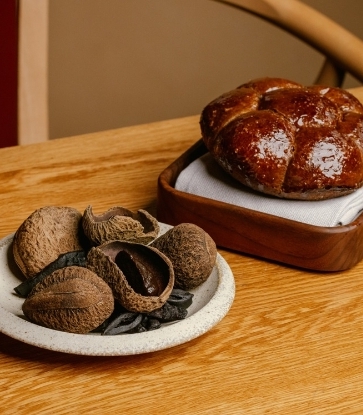
“My family and I used to spend Easter holidays in Corfu on a regular basis during my childhood, so the smell of freshly baked tsoureki is something I cannot forget when walking around the streets of Corfu town in the early morning”, he says. “There is a cookie version of these as well; they usually don't last long with me around”.

The tsoureki keeps well over a few days, and in fact tastes even better after two or three days. Simply store in a plastic wrap or container, and enjoy with a nice Greek coffee.

Makes 3 loaves (approx. 400g each)
Time required:
Mixing 15 min
Bulk fermentation 1.5 hour
Proofing 4 hours
Baking 30-40 min
For the coloured eggs:
50 grams vinegar
10 grams water
Few drops of red colouring
1. Boil the eggs for about 10 minutes till they are hard-boiled; transfer to wire rack.
2. In a small bowl, mix the vinegar, water and red colouring.
3. Wearing a rubber or plastic glove, coat each egg in the coloured solution, and leave to dry on a cooling rack for few minutes before repeating the colouring process a second time to deepen the colouring. Let fully dry for 15 mins.
4. Sprinkle olive oil onto a piece of kitchen paper roll and rub each egg with it until shiny.
5. Save at room temperature for later.
For the dough:
150 grams stiff starter (white flour sourdough)
300 grams water
500 grams bread flour
2 eggs
50 grams melted unsalted butter
20 grams caster sugar
150 grams wild honey
10 grams vanilla extract
15-20 grams mahleb
5 grams ground cardamom
12 grams sea salt
100 grams soft unsalted butter
Egg white for brushing
Shredded almonds for garnish
1. In a mixer at low speed with a dough paddle, dissolve the stiff white sourdough in water for about 1
min. Add eggs, melted butter, honey, sugar, mahleb, ground cardamom, orange zest, vanilla extract and continue to mix at medium speed for about 3 mins. Add organic white flour in 3 batches and continue to mix at medium speed (approx. 5 mins).
2. At the end of mixing, add sea salt to strengthen the gluten in the dough.
3. Replace the dough paddle with a dough hook.
4. Add soft butter and beat at medium-high speed for about 5 mins. Stop the mixer once and scrape the bowl to make sure all the butter is full incorporated. Finish mixing (max 3 min).
5. At the end of beating, the dough should be a bit sticky and batter-like. Do a ‘windowpane test’ by pinching off a ball of dough, flattening it and holding it between your thumb and first two fingers. When you slowly spread the dough apart, it should stretch without tearing, forming a thin membrane.
6. Transfer dough from mixing bowl onto well-floured kitchen bench. Gently finish the kneading by hand and shape the dough into one large ball.
7. Place the dough in well-buttered bowl, coat in butter to prevent drying and cover with kitchen towel to rest.
8. After the first 30 mins of bulk fermentation, stretch and fold the dough before covering with a kitchen towel and let rest again. Place in a cool area and let bulk fermentation continue for another 60 mins.
9. Transfer the dough onto a well-floured kitchen bench, roughly roll the dough and stretch it into a long stick shape. Fold in half, and repeat the same process about 10 times. You may sprinkle some flour to help this stretching process to avoid sticky dough onto the bench. You want to make sure you get the elasticity which will get you the desired chewiness of the tsoureki crumb.
10. Divide the dough into 4 pieces, shaping each one into a long stick (like a baguette), and braid the bread using a 4-strand braiding technique.
11. Once you have achieved one braided loaf, cut it into 3 equal loaves, tidy up the edges by tucking them underneath each loaf.
12. Transfer all 3 loaves onto a baking tray covered with baking paper.
13. Place a colored egg in each loaf by pushing it into the dough till it is almost half covered. Brush each loaf with egg white wash and sprinkle with the almonds. Let proof for another 45-60 minutes.
14. Bake for about 25-30min in a preheated 190˚C oven.
15. Remove from oven; leave to cool on a wire rack.













